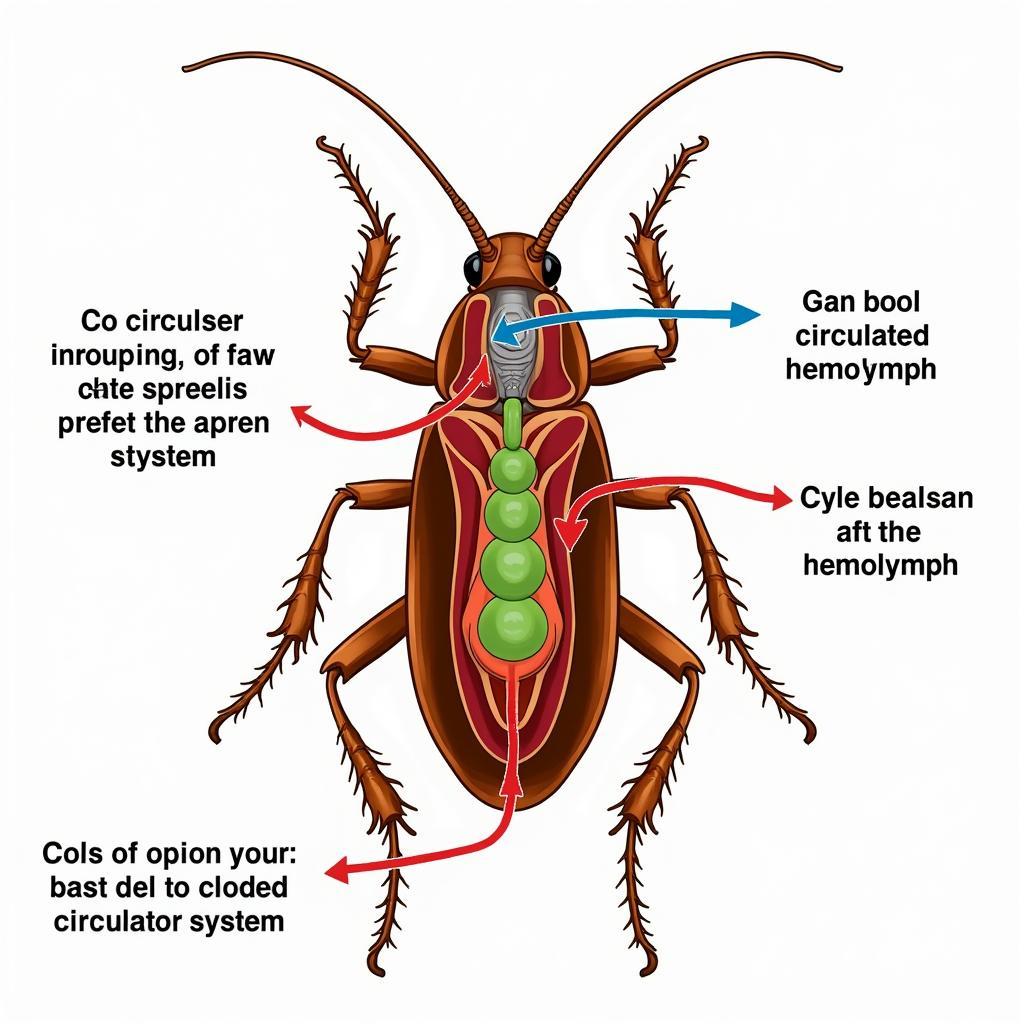Cockroach blood isn’t the crimson red we’re used to seeing in mammals. So, what color is cockroach blood? It’s typically colorless or a pale yellowish-white. This intriguing fact sparks curiosity about their unique biology and how these resilient pests function. Let’s delve into the fascinating world of cockroach hemolymph and explore why it lacks the vibrant red hue we associate with blood.
Decoding the Mystery of Cockroach Blood Color
Unlike humans and other vertebrates, cockroaches don’t utilize hemoglobin to transport oxygen. Hemoglobin, rich in iron, gives our blood its characteristic red color. Cockroaches, however, employ a different system. Their blood, more accurately called hemolymph, doesn’t carry oxygen. Instead, they breathe through a network of tubes called tracheae, delivering oxygen directly to their tissues.
Why is Cockroach Blood Colorless?
The absence of hemoglobin is the primary reason cockroach blood lacks color. Hemolymph primarily consists of water, along with various nutrients, hormones, and immune cells. It plays a crucial role in transporting these substances throughout their bodies, but oxygen transport isn’t one of its functions.
The Role of Hemolymph in Cockroaches
Although not involved in oxygen transport, hemolymph is vital for cockroach survival. It helps maintain their internal pressure, transports nutrients and waste products, and plays a role in their immune response. This fluid is essential for their molting process, helping to transport the components necessary for building their new exoskeleton.
Comparing Cockroach Blood to Other Insects
Many insects share a similar colorless or pale yellowish blood due to the absence of hemoglobin. Like cockroaches, they rely on tracheal systems for respiration. However, some insects with different respiratory mechanisms may have blood with varying colors, influenced by the pigments in their hemolymph.
Do All Cockroaches Have the Same Blood Color?
While generally colorless or pale yellow, slight variations might exist among different cockroach species due to dietary factors or other environmental influences. However, the lack of hemoglobin remains consistent, resulting in the absence of red pigmentation.
What Happens When a Cockroach is Injured?
If a cockroach is injured, its hemolymph will leak out. Because the volume of hemolymph is relatively small compared to their body size, even a small injury can be significant. However, their clotting mechanism helps seal the wound and prevent excessive hemolymph loss.
Debunking the Myth of Red Cockroach Blood
Some people mistakenly believe cockroach blood is red. This misconception might arise from observing crushed cockroaches where other internal fluids and tissues can mix, creating a reddish appearance. However, the hemolymph itself remains colorless.
What Does the Color of Cockroach Blood Tell Us?
The color, or lack thereof, in cockroach blood provides valuable insights into their evolutionary adaptations and survival strategies. Their efficient tracheal respiratory system negates the need for hemoglobin-rich blood, allowing them to thrive in diverse environments.
“The colorless hemolymph of cockroaches is a testament to their unique respiratory system, allowing them to efficiently deliver oxygen directly to their tissues without relying on hemoglobin,” says Dr. Amelia Sanchez, an entomologist specializing in insect physiology.
Cockroach Blood and Pest Control
Understanding cockroach physiology, including their circulatory system, is crucial for developing effective pest control strategies. While their blood color itself doesn’t directly impact pest control methods, knowing their biological mechanisms helps target their vulnerabilities.
“Knowledge of cockroach physiology is paramount in devising targeted pest control strategies,” adds Dr. Sanchez. “By understanding their unique adaptations, we can develop more effective and sustainable methods for managing these resilient pests.”
Further Research and Exploration
The study of cockroach hemolymph and its components continues to unveil further insights into their biology and potential applications in various fields, including medicine and materials science.
 Cockroach Anatomy: Circulatory System
Cockroach Anatomy: Circulatory System
In conclusion, what color is cockroach blood? It’s typically colorless or pale yellowish-white due to the absence of hemoglobin. Their unique respiratory system, utilizing tracheae for direct oxygen delivery, eliminates the need for red blood. Understanding this fascinating aspect of cockroach biology provides valuable insights into their remarkable adaptability and resilience.
FAQ
- Is cockroach blood the same as human blood? No, cockroach blood, called hemolymph, is different from human blood. It doesn’t carry oxygen and lacks hemoglobin, resulting in a colorless appearance.
- Why is cockroach blood important? Hemolymph is essential for transporting nutrients, hormones, and waste products, maintaining internal pressure, and supporting their immune response.
- Can you see cockroach blood? Yes, if a cockroach is injured, you might see a small amount of colorless or pale yellowish hemolymph leaking from the wound.
- Does cockroach blood carry oxygen? No, cockroaches use a tracheal system for respiration, delivering oxygen directly to their tissues without the need for blood to carry it.
- What is the main component of cockroach blood? Water is the primary component of cockroach hemolymph, along with other substances like nutrients, hormones, and immune cells.
- What happens if a cockroach loses a lot of blood? Because their hemolymph volume is relatively small, significant loss can be detrimental to their survival.
- Does cockroach blood have any practical applications? Research on cockroach hemolymph and its components is ongoing, exploring potential applications in various fields.
Need Help with Pest Control?
When you need assistance with cockroach infestations or other pest control concerns, don’t hesitate to reach out to us. Contact us at Phone: 0373298888, Email: [email protected] or visit us at 86 Cau Giay, Hanoi. Our customer service team is available 24/7 to assist you.
We also have other helpful articles on our website related to pest identification and control. Check them out for more information on managing pests effectively.

